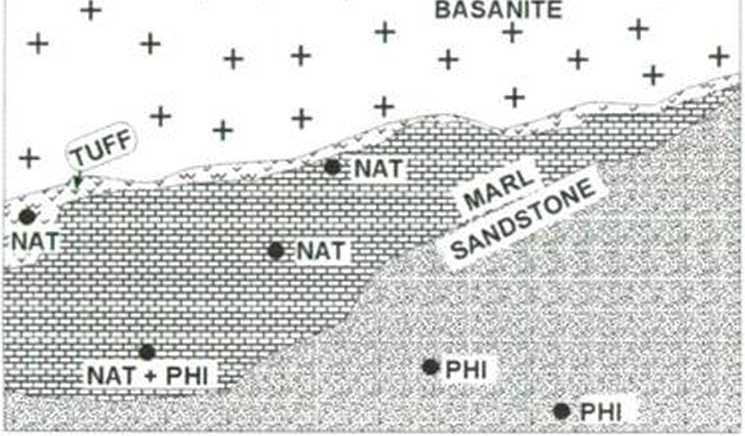9058009747
Acta Mineralogica-Petrographica, Abstract Senes 4. Szeged, 2004
ZEOLITE AND CLAY MINERALS AT THE CONTACT OF CRETACEOUS MARLS WITH TERTIARY BASANITE (GRACZE QUARRY, OPOLE, SILESIA, POLAND)
SZELIGA, W.
Institute of Geologica! Sciences, Jagiellonian University (Instytut Nauk Geologycznyh, Uniwersytet Jagielloński], Oleandry 2a, Kraków, 30 063, Poland
E-mail: szeliga@geos.ing.uj.edu.pl
The contact metamorphism of Cretaceous marls (lower Senonian-Coniacian) (Alexandrowicz and Birkenmajer, 1973) and hydrothennal alteration of tuff in neighbourhood of Tertiary basanites from the Gracze quarry were studied.
Samples collected in the Gracze quarry represent marls and tuff conected with the first stage of volcanic eruptions. According to Kapuściński and Probierz (1999), tuff is com-posed of pyroxene (augite and diopside), olivine, magnetite, nepheline, clay minerals (illite, montmorillonite) and zeolites (chabasite series). Calcite, serpentine and zeolites replace primary olivine.
Recently the progress of exploitation allowed to collect samples undcr the basanite. Scanning electron microscope with cnergy dispcrsivc spectrometry, X-ray diffractometry and optical microscopy were used for the investigations.
The studied tuff is composed of pyroxene (augite-diop-side), nepheline, Fe-, Ti-oxide minerals, calcite, serpentine and smectite. Zeolites represent two groups: natrolite type (NAT according to International Zeolitc Association classifi-cation; Baerlocher et al., 2001) and phillipsite type zeolites (PHI according to this classification). Chemical composition of zcolite minerals is strongly variable, especially in the con-tents of Fe, K and Mg. Natrolite is present in tuff elose to the basanite-marls contact and phillipsite dominates in tuff situa-ted between lava flows. Natrolite occurs in marls elose to the cotact; phillipsite is present in samples collected from the lower part of the profile (marls and sandstones beneath marls; Fig. 1). Phillipsite is also present in one sample of marł collected in strongly tectoniscd zonę.
Zcolite minerals occur in spherical forms, grown in the tuff and in lower amount in marls. Spherical forms are also present in cracks in marls. Morphology of zeolite crystals is variable: euhedral prismatic crystals (in tuff and marls) often are over-grown by fibrous branchy zeolite (only in tuff'). Almost pure smectite was identified in all tuff samples. In marls I/S mixed layer minerals are present together with mica.
It seems that crystallisation of natrolite and phillipsite was not related separately to temperaturę or Chemical composition of solution, but resulted form overlapping of both of these factors. Probably also other factors were important (e.g. solution-rock ratio controlled by rock permeability). Tempe-ratures detennined experimentally (Wirsching, 1979; Wir-sching, 1981) for growth of Na zeolites (natrolite) were described by as lower than cca. 150°C (at pH ~ 12.5 and surplus of Na*).
+ ++ ++ + + + +

Fig. 1: Sketch of localisalion ofdifferent zcolite phases (NAT: natrolite, PHI: phillipsite)
Phillipsite crystallises at higher temperaturę rangę from 150-250°C (at pil 12-13; Kawano and Tomita, 1997). For growth of phillipsite phase in thosc temperatures fluids with surplus of K’ ions are necessary (Wirsching, 1979).
Crystallisation of secondary minerals was related to hydrothermal fluids activity. The sequence: euhedral zeolite —> fibrous branchy zeolite —* smectite was related to the decreasing temperaturę. Ions necessary to growth of these minerals were supplied from decomposition of primary minerals in tuff and basanite.
Acknowledgements
This study was supported by State Committee of Scientific Researches (KBN) grant no. 3-PO4D-035-24.
References
Alexandrowicz, S. w., Birkenmajer, K. (1973): Bulletin de PAcademie Polonaise des Sciences - Sciences de la Terre, 21,45-49.
Baerlocher, C. H., Meier, w. m., Olson, D. H. (2001):
Atlas of Zeolite Framework Types. Elsevier, London. Kapuściński, T., Probierz, M. (1999): Ceramika - Materiały Ogniotrwałe, 3/99, 86-95
Kawano, M., Tomita, K. (1997): Clays and Clay Minerals, 45, 365-377.
WIRSCHING, U. (1979): Neues Jahrbuch fiir Mineralogie -Abhandlungen, 134, 193-207.
WIRSCHING, U. (1981): Clays and Clay Minerals, 29, 171 — 183.
103
www. sci. u-szeged. hu/asvanytan/acta.htm
Wyszukiwarka
Podobne podstrony:
Acta Mineralogica-Petrographica, Abstract Senes 4, Szeged, 2004TEMPERATURĘ AND PRESSURE EFFECTS ON
Acta Mineralogica-Petrographica, Abstract Senes 4, Szeged, 2004NANO AND MICRO PARTICLES ON BENTONITE
Acta Mineralogica-Petrographica, Abstract Senes 4, Szeged, 2004MINERALOGICAL AND CRYSTAL CHEMICAL AS
Ada Mineralogica-Petrographica, Abstrad Senes 4, Szeged, 2004MINERALOGICAL AND GEOCHEMICAL CHARACTER
Acta Mineralogica-Petrographica. Abstract Senes 4, Szeged, 2004SYNTHESIS, CHARACTERISATION AND CATAL
Acta Mineralogica-Petrographica, Abstract Senes 4, Szeged, 2004CRYSTAL CHEMISTRY OF TALC: XRD AND SP
Acta Mineralogica-Petrographica, Abstract Senes 4, Szeged, 2004STRUCTURAL, THERMAL AND SURFACE FORCE
Acta Mineralogica-Petrographica, Abstract Senes 4. Szeged. 2004ANKARA CLAY: ITS GEOLOGY, MINERALOGY,
Acta Mineralogica-Petrographica, Abstract Senes 4, Szeged, 2004THE CRYSTAL CHEMICAL EVOLUTION OF
Acta Mineralogica-Petrographica, Abstract Senes 4, Szeged, 2004CLAY PIGMENTS AS INDICATORS OF PAINT
Acta Mineralogica-Petrographica, Abstract Senes 4, Szeged, 2004TEM-STUDY OF MUSCOVITE-CHLORITE MIXED
Acta Mineralogica-Petrographica, Abstract Senes 4, Szeged, 2004CHEMICAL RESISTANCE OF CEMENT-BENTONI
Acta Mineralogica-Petrographica, Abstract Senes 4, Szeged, 2004EFFECT OF THE Ni-Al HYDROTALCITE-LIKE
więcej podobnych podstron